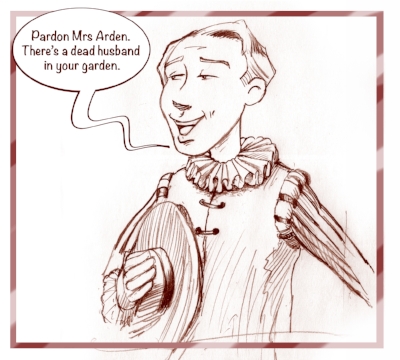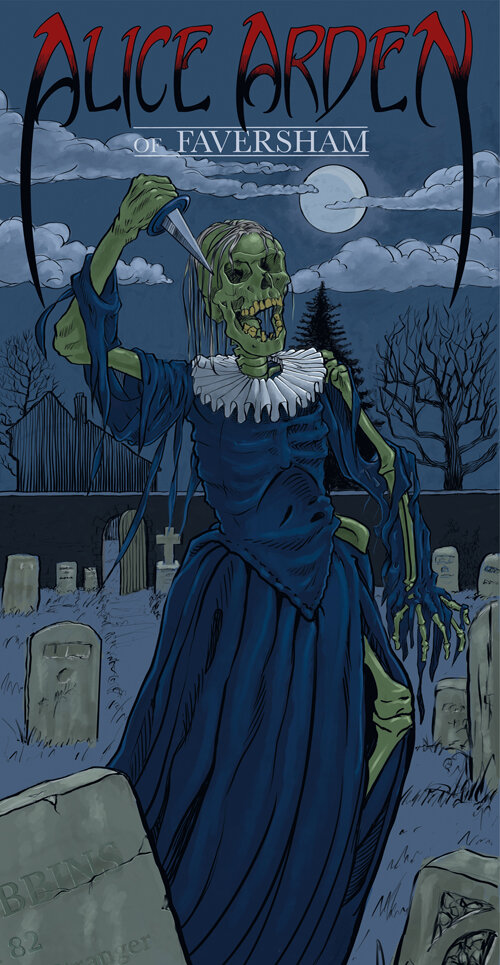Ardens of Faversham
This entry will mostly be illustrated with rough pencil sketches as there are quite a few drawings and I’m pressed for time. It’s already taken me four months plus I have a day job.
I live in a medieval market town called Faversham. Arden House nestles a few hundred yards from the town centre, right next to an old, old churchyard.
This was drawn with a dip pen and ink on smooth paper. The scratchy quality gives it a rustic feel. The perspective is a little out but these old buildings are always a bit wonky. I have used a little artistic license with this drawing to make it look less 1970’s than it does in reality.
This is the site of a very gruesome episode in the history of Faversham. Way back in the 1550s a merchant by the name of Thomas Arden married the young, beautiful and wealthy Alice Brigantine and moved her into this building, a former guest house of the Benedictine Abbey.
Thomas Arden as he most likely looked
A stunner! Alice Brigantine.
For the next few years, Arden concentrated on acquiring more wealth and power and neglected his marital duties. It is tempting to surmise that he may have been gay but this can’t be the case as homosexuality wasn’t invented until around 1763. Whatever the reason, poor, lonely Alice was left to her own devices and as she was a bit of a strumpet her devices turned to vices and her vices led her to the arms of another man, a tailor known as Richard Moseby.
Gorgeous
I have drawn him with his head at a jaunty angle to emphasise his rugged good looks. In fact, attractive people didn’t really come about until 1927, so he probably looked more like this…
Pen and Ink, I liked this ugly face and him up as a treat to myself.
Alice and Richard were quite open about their affair. Thomas decided to accept the situation rather than sever ties with Alice’s influential family.
Alice grew to loathe the man and eventually decided to do him in. First she tried to poison him, but when this failed Alice decided she needed help and enlisted the aid of several conspirators, one being ex-soldier turned murderous highwayman Black Will of Calais.
Eeeeevil
He was introduced to her by John Green, a local man who had a grievance against Thomas, due to a property dispute.
Perhaps a slight over reaction, although bicycle pumps were quite hard to come by in those days
Several more plans were made to kill Arden but when these came to nothing. Wicked Alice arranged for an ambush within Arden House. To this end she inveigled more conspirators, including servants, Richard Moseby’s sister and her own 15-year-old daughter Margaret.
Drawn on my ipad using the “Brushes” app.
And so it was that at 7 p.m. on the 14th of February 1551, Richard sat down with Thomas for a friendly game of backgammon. (Buckaroo had not yet been invented and Twister lacked the finesse of the modern version.) Upon a signal from Richard, Black Will jumped out of a cupboard behind Thomas, brandishing the deadliest of weapons … a napkin. (This goes some way to explain why previous attempts had come to nothing.) Obviously napkins were made of sturdier stuff back then as Black Will was able to throttle him with it, while Moseby lamped him with an iron and slashed his throat.
Violent... and why are there only white backgammon pieces?
Alice then put her two-pennies worth in and stabbed him seven times for good measure.
More violence
Once the wicked deed was complete, all the conspirators worked together to clean up the crime scene. The body was dumped in a field next to the church yard, just outside the garden gate.
It was a snowy night.
Not long after this, invited guests began arriving for a late supper. Much singing and gaiety ensued with Margaret playing the virginals. (I tried playing the virginals once and all it got me was a slapped face.) To allay suspicions, Alice audibly wondered about the lateness of her husband.
while uploading this image, I was aghast to realize I hadn’t given her any ears. But when I researched the whole affair again I noticed that at no time are her ears mentioned. Did she have ears? I doubt we’ll ever know one way or another.
The next morning wicked Alice alerted the town that her husband was missing and the body was soon discovered. It would be nice to think that Alice was accosted at the door by the marshal quipping…
Unfortunately, that rhyme hadn’t yet been made up. pardon Mrs Arden there’s a kitten/chicken in your garden was the first verse of a music hall rhyme, intended to make fun of the way some provinces pronounced “en” as “ing” as in Parding Mrs Arding there’s a chicking in your garding. You can see why music hall died out and was quickly replaced a new idea known as “entertainment”.
It seems likely that Alice was already under suspicion from the locals but when the trail in the snow lead from the corpse to her parlour door, a search was undertaken. The bloody murder weapons were found and Alice soon confessed, implicating all the other conspirators for good measure. Most of the guilty and some not-so-guilty were quickly apprehended… In all sixteen people were executed for the murder of Thomas Arden, including fifteen-year-old Margaret.
This is drawn with the “Brushes” ap
Black Will is rumoured to have escaped to London, joined a little theatrical company and written some plays, one of which was called The Ardens of Faversham… Some others you may have heard of were: Macbeth, Romeo and Juliet, and Whoops! There Goes My Knickers. That’s right! Black Will was none other than … William Shakespeare!*
Alice was burnt slowly at the stake just outside Canterbury, leaving us with that age-old life-lesson, if you do want to kill your husband, don’t make it so bleeding obvious.
My interest in Alice Arden was piqued the other day when I actually saw her ghost wandering around the churchyard behind her house! As I knew no one would believe me, I asked her to stand still for a while so I could draw her. Here’s the proof.
This is a very rough thumb nail sketch. I will be developing this into a finished poster that will be available to buy. I want to show all the stages from first rough to finished poster. Watch out for the next exciting instalment.
And Here’s the next instalment….
Available to buy at Etzy……
*This of course is complete rubbish. The play was written 41 years after the event and although Black Will did escape immediate capture, he was eventually apprehended and likely hanged in Flanders. I made up that intrigue as a joke. It’s as ridiculous as Patricia Cornwell deciding that Walter Sickert was Jack the Ripper because his paintings were a little creepy. There is however, a Shakespeare connection. There is strong stylometric evidence that the play The Ardens of Faversham was at least partly written by Shakespeare. Also his acting troupe are known to have toured the area and as Shakespeare’s mother’s maiden name was Arden we can safely assume that his interest would have been piqued. I’m also pretty sure he would have bought one of my posters if they were available in his day.
https://www.theguardian.com/culture/2016/oct/23/christopher-marlowe-credited-as-one-of-shakespeares-co-writers
If Shakespeare had been Black Will
Another notable thing about Faversham is that Sir Bob Geldof lives here. I will endeavour to interview him for my next blog entry; it won’t take as long as this last one. Don’t forget the next instalment of the Alice poster.


















